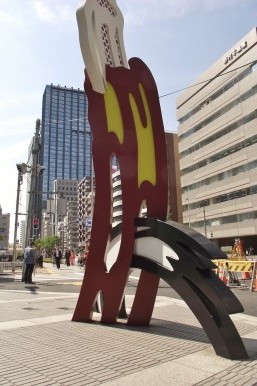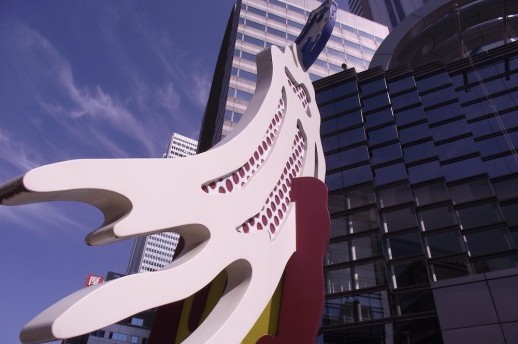Public Art #1: Roy Lichtenstein’s Tokyo Brushstrokes

Beneath a brilliant blue sky in May in Nishi-Shinjuku stands one of two public sculptures by Roy Lichtenstein. Made from four bold brushstrokes in primary colours and Ben-Day dots, Tokyo Brushstroke II emerges from the ground as though surfing on a comic book arc of paint, ascending with two upward sweeps before a final flourish on top. Tokyo Brushstroke I stands a little further along the street and is also made from four vertical marks that lace through one another skywards. Despite being the taller of the duo, Tokyo Brushstroke I sinks into the midday shade of the I-Land complex, overshadowed by the forty-four storeys of steel and glass beside it.
While Tokyo doesn’t have the same policy-driven investment in public art as many other cities around the world, every now and then a passerby may come across something rather special. In this instance, there is effectively a haven of art installed among the vast structures of the skyscraper district of west Shinjuku. Curated by Fumio Nanjo and Associates in the early nineties, Shinjuku I-Land Tower’s sculptures were a part of sixteen public art installations by eleven artists. The list also includes 10 or so artworks by artists such as Giuseppe Penone, Giulio Paolini, Luciano Fabro, Daniel Buren, Katsuhito Nishikawa, Hidetoshi Nagasawa, as well as one of the thirty-seven versions of Robert Indiana’s Love (1995), located on the other side of the tower from Lichtenstein’s contributions.
CommissioningTokyo Brushstrokes seems to have satisfied the curator’s appetite for pop culture, a graphic bridge between comics and manga, whilst also ensuring that the works were shorthand for art too. The works themselves are somewhere between things. They’re between two and three dimensions, between abstraction and representation, between appropriation and creation, and between painting and calligraphy. In remodeling something that may ordinarily be an ephemeral gesture, such as the flick of a paintbrush, into something so concrete, Brushstrokes trace the artist’s mark. Like signatures standing upright, they are specific indexes that have been selected to both occupy and inscribe the space at the same time.
True to his methodology, Lichtenstein’s starting point for this body of work was found within a comic strip frame of someone painting a fence – with only the brush, the brushstroke and the painter’s hand visible. It’s a curious idea. Instead of the brushstrokes being secondary to what is depicted with the paint, Lichtenstein reduces the medium of painting to a single gesture and makes that the subject matter. It’s also interesting that the sculptures were made by commercial fabricators, like oversized billboards; theoretically at least, they too could be reproduced again and again. And so the contradictions multiply. Tokyo Brushstrokes represent the unique traces of an artist, made by fabricators, to depict paint, in the style of a print process, in three dimensions.

Speaking in the film Tokyo Brushstrokes, a documentary made specifically about this commission, Lichtenstein says, “It’s a symbol of something it isn’t and that is part of the irony I’m interested in”. If they don’t represent what they are of then what are the broader ironies at play? They’re about saluting painting whilst speaking of its limitations; they’re about being accustomed to borrowed imagery whilst pursuing the quest for originality; they’re about the uniqueness of a mark made whilst acknowledging its reproducibility; they’re about the value given to the masterly handling of paint and the exalted mysticism of the artist; and they’re about the possibilities of public art to create impossible objects in open spaces, in this case, ones that manage to combine the heroic with the absurd.
Tokyo Brushstroke I and Tokyo Brushstroke II are at 6-5-1 Nishishinjuku, Shinjuku or at these coordinates: 35.694010, 139.693355
Nick West
Nick West



